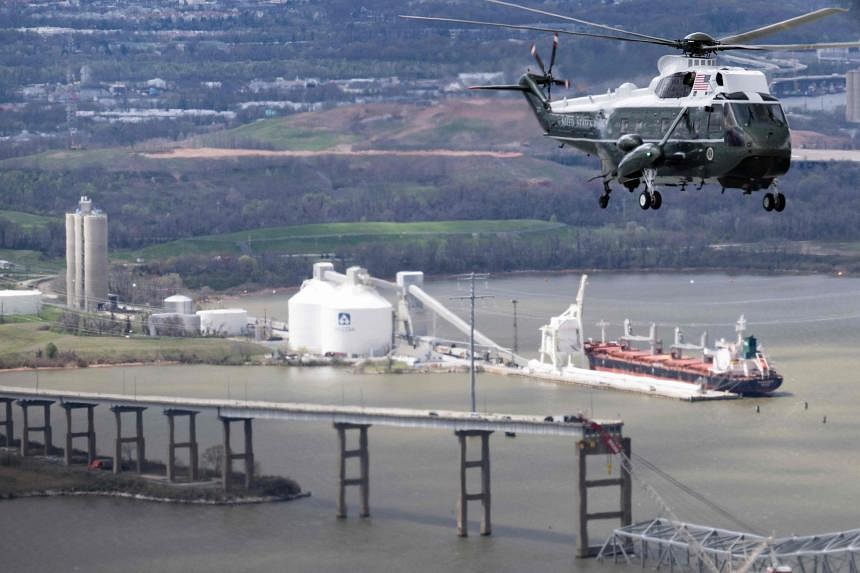BALTIMORE – US President Joe Biden visited the Francis Scott Key Bridge disaster site on April 5, vowing to fund the rebuilding of the bridge.
But will the Republicans go along?
Stakes are high as the authorities work to clear tonnes of steel and concrete from the Patapsco River into which the bridge collapsed after it was struck by a Singapore-flagged cargo ship on March 26, in what is believed to be the most expensive disaster in maritime history.
“From the air, I saw the bridge ripped apart, but here on the ground, I see a community that’s pulled together,” Mr Biden told the media after an aerial tour.
The crippled Port of Baltimore, the 11th busiest in the country, will be fully operational by end-May, officials announced during his trip.
A temporary, alternate channel to help salvage vessels cut sections of the bridge and cart them away has been functioning since April 1 – all during bad weather. The port has seen severe thunderstorms and high winds over the week.
Mr Biden reiterated his pledge that the federal government will foot the entire cost of rebuilding the bridge, which was knocked down when the container ship Dali lost propulsion and became adrift before it hit the 2.6km, four-lane bridge.
The bridge crumbled within minutes, with a large section collapsing atop the ship, which is stranded in the waters with nearly two dozen crew members still aboard.
“I’m here to say your nation has your back,” Mr Biden said, going on to mention his generations-old family ties with Baltimore that include his father, who was born and raised in Maryland’s capital city, Annapolis.
“We’re going to move heaven and earth to rebuild this bridge as rapidly as humanly possible,” he said, adding in a nod to his Democratic base: “And we’re going to do so with union labour and American steel.”
The conservative wing of the House of Representatives, the House Freedom Caucus, has released a list of conditions for federal funding to rebuild the bridge, which could cost up to US$1 billion (S$1.35 billion).
Among other things, House Republicans want the government to first seek “maximum liability from foreign shipping companies upfront” for the damage.
They also want environmental and union wage rules paused “to avoid all unnecessary delays and costs”.
Eight workers were filling potholes on the bridge when it was hit. Two were rescued and the bodies of two have been recovered, with the others presumed dead.
Mr Biden met the families of the affected workers during his visit, the White House said.
Investigations into the cause of the disaster are being carried out by the US National Transportation Safety Board. Teams from the Maritime and Port Authority of Singapore and the Transport Safety Investigation Bureau are also involved.
As much as US$200 million in cargo moves daily through Baltimore port, the leading US hub for importing and exporting cars and light trucks.
Who will fork out billions in losses?
There will be protracted wrangling over who will pick up the tab for losses, including the cost of rebuilding the bridge, repairing the Dali and compensating companies for the disruption of port operations.
Morningstar DBRS, a global credit rating agency, said insured losses could amount to up to US$4 billion, depending on how long the port is inoperable. Barclays has estimated that insurers face claims of as much as US$3 billion.
The accident is likely to result in the largest maritime insurance payout since 2012, when the Costa Concordia cruise ship ran aground off the Italian island of Giglio, killing 32 people. Some US$1.5 billion was paid out in damages then.
“It’s natural that the owner and the manager have tried to reduce the amount that they will be found liable for,” said Mr Jerry Theodorou, director of the finance, insurance and trade policy programme at R Street Institute, a non-partisan public policy research organisation based in Washington.
The ship’s owner Grace Ocean and manager Synergy Marine, both based in Singapore, filed a petition in a federal court in Maryland on April 1, saying they are not responsible for the accident.
They also said that if they were held liable, the damages should be capped at around US$44 million, the current value of the ship and its cargo minus the damage and salvaging cost.
An 1851 admiralty law caps a shipowner’s liability to the post-crash vessel value. Thus, the owners can be held responsible for only tens of millions of dollars when, in the absence of the admiralty law, third-party liability losses could easily climb to nine figures.
The current rules stem from the way marine insurance and admiralty law developed in the US after World War I.
“At the time, British companies dominated the marine insurance market, and the US wanted to have a little bit of a competitive situation with the UK insurers,” said Mr Theodorou.
In the early part of the 20th century, there was a hearing that paved the way for some special advantages that US marine insurers would have, he added.
The bridge was reportedly covered by multiple insurers, led by the Switzerland-domiciled Chubb Corporation, for US$1.2 billion.
The insurers paying claims on the bridge will subrogate against the shipowners, meaning they will recoup their loss by suing at-fault shipowners, said Mr Theodorou.
“Already, people are talking about the US$4 billion loss, which is the biggest marine loss ever. No single organisation or entity is going to take it on the chin completely. Because the number is so big, it involves dozens of entities and many insurance and reinsurance companies,” he added.
The biggest piece of it would be the top-level reinsurance that is about US$3 billion, which is provided by about 80 insurance and reinsurance companies, he said.
The settlement of claims could take years.
“A number of factors make it rather complex, above and beyond the size of the claims,” said Mr Theodorou.
“It’s going to be in many tranches, many different suits and many different kinds of losses.”
Asked for an estimate, he added that the process could take up to a decade. “Five to 10 years is not out of the picture,” he said.





